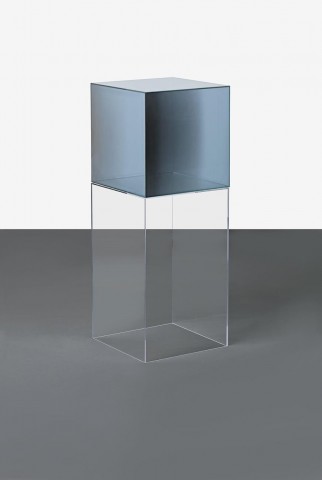CUBE #20, 2005
LARRY BELL
glass coated with Inconel on a plexiglass base
51.0 x 51.0 x 51.0 cm
117.5 x 51.0 x 51.0 cm (including base)
Annandale Galleries, Sydney
Private collection, Melbourne
LARRY BELL, Cubes and Works on Canvas, Annandale Galleries, Sydney in association with Bernard Jacobson, London, 17 May – 3 June 2006 (illus. on exhibition catalogue cover)
Shimmering with competing silvery-blue reflections, Cube #20, 2005 is a brilliant late example of Larry Bell’s trademark glass constructions. These cubes, executed with slightly larger dimensions than their 1960s predecessors, each display a controlled handling of vacuum-coated, iridescent Inconel, a nickel-chrome alloy deposited on each surface in layers only a micron thick. A cigar-smoking maverick artist, Bell has spent the last fifty years creating artworks that explore perception. Using panes of glass to bend the reflective and refractive properties of light, his sculptural interventions present and then withdraw from view what physically lies before us. Bell aptly describes the range of effects he creates as similar those produced by the iridescence of a layer of gasoline floating on a pool of water.1 The delicate blue hues of Cube #20 change in parallel with minor alterations to the angles of illumination and view, creating an artwork that is in constant symbiotic response to both its environment and its viewer.
Informed by the contrast between Los Angeles’ burgeoning industrial aesthetic and the vast expanses of sky that surrounded its metropolis, Larry Bell’s sculptures have been associated with the Minimal, Conceptual and Light and Space movements. Whilst elements of these movements can be found in Bell’s art, particularly in his iconic Cube works, the artist paid little attention to the theoretical discussions about art. He preferred to focus, with dogged commitment, on his own investigations.2 A strong link was nevertheless created between Bell, his teacher Robert Irwin, the pioneering installation artist, and the generation of process-based artists that followed them both. Bell shared with his fellow artists working in Venice, Southern California in the 60s and 70s a strong desire to incorporate cutting edge industrial and technological innovation into their creative process. The process became, in turn, an integral part of their artwork. The visually stimulating works produced by these young artists embodied the ultra-cool West Coast aesthetic of the late 20th century.
Making light, the most elusive of physical properties, his primary medium, Bell’s work was deeply set into the early framework of participatory art, incorporating the viewer and the wider installation context into the artwork itself. Sculpture has an inherent materiality that requires the object to inhabit our physical reality. Bell takes this quality one step further, using light as an intangible bridge between the sculpture and the viewer, allowing the artwork to transcend its physical confines.
1. The artist cited in Gregory, B., foreword to exhibition catalogue LARRY BELL, Cubes and Works on Canvas, Annandale Galleries, Sydney, 2006
2. ‘Our Last Hurrah: Larry Bell’, In the Make, January 2015, accessed online 16 March 2018 (http://inthemake.com/our-last-hurrah-larry-bell/)
LUCIE REEVES-SMITH
